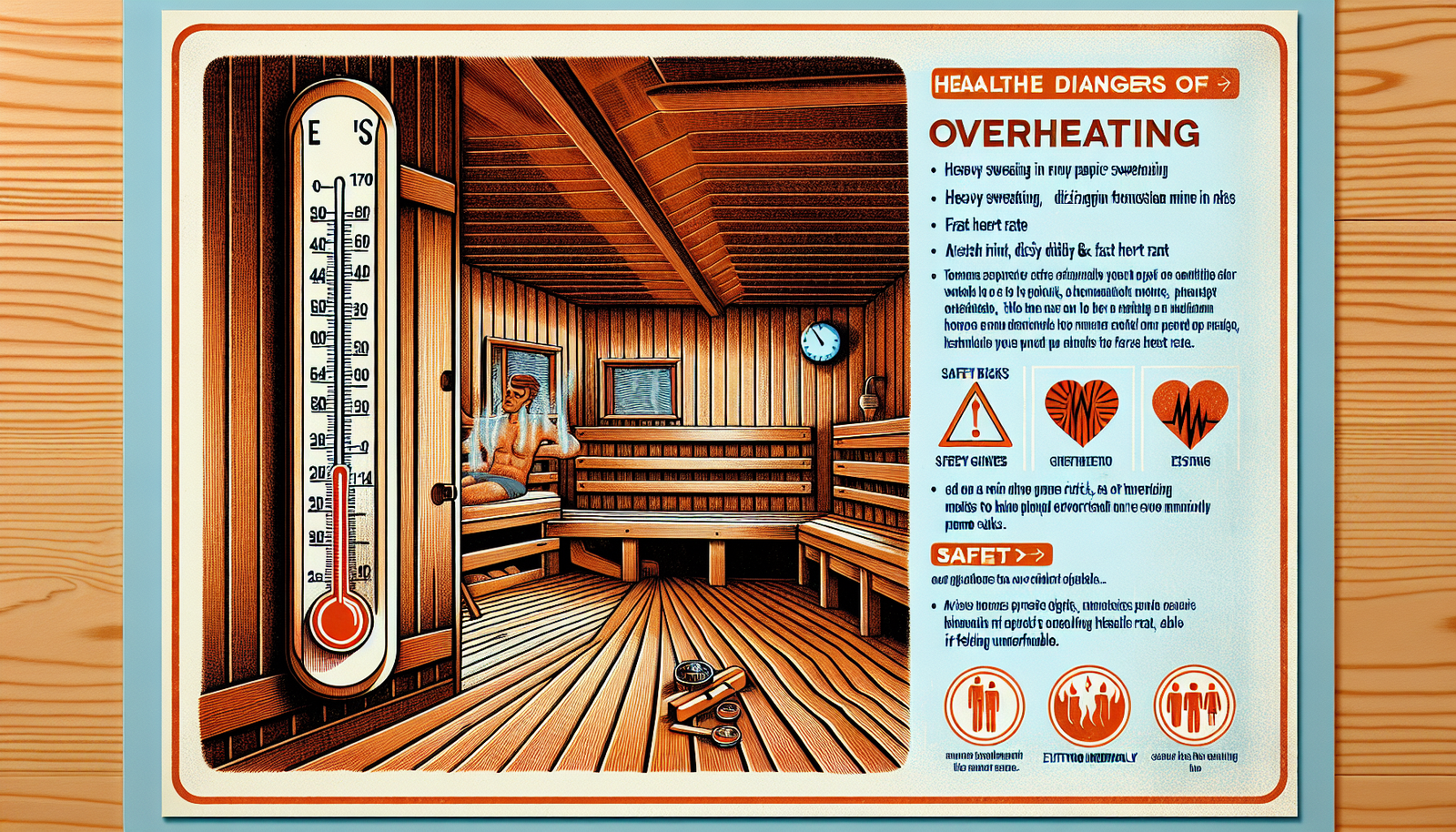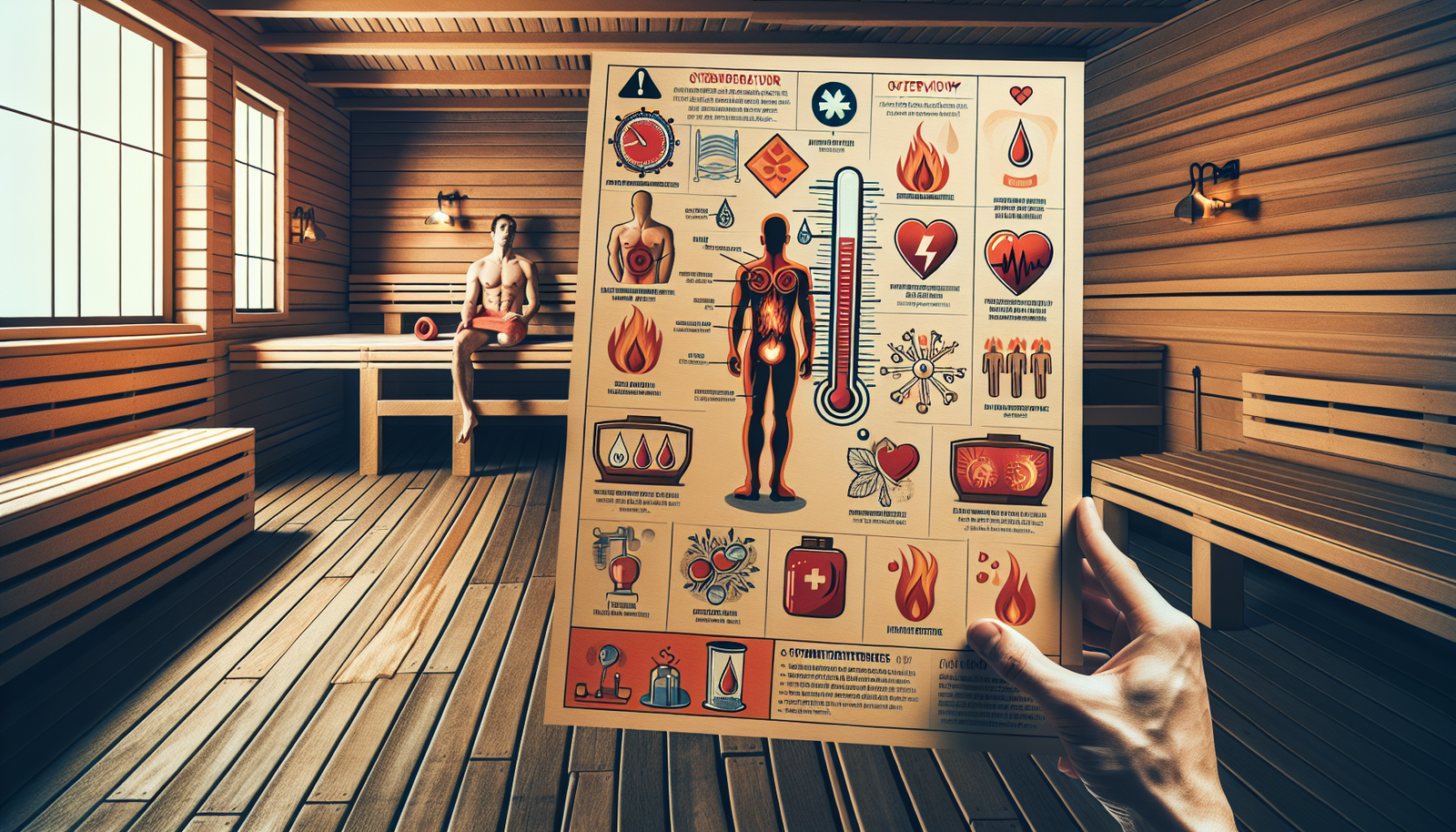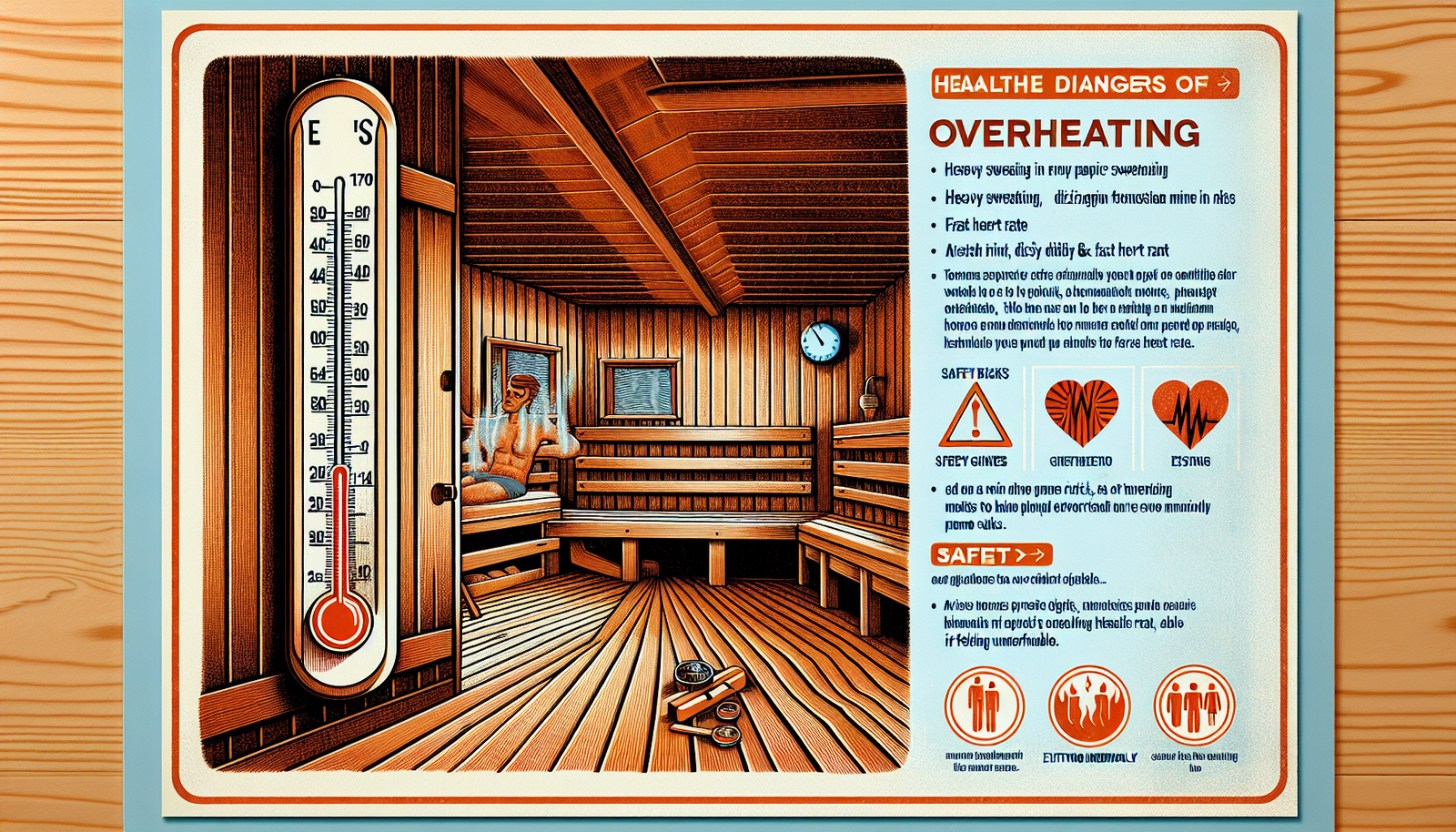Step into the world of saunas and discover the hidden secret to finding your perfect temperature. In this article, we will explore the tell-tale signs that indicate whether a sauna is too hot for you. From the feeling on your skin to the clarity of your mind, understanding these subtle indications will help you make the most out of your sauna experience. So, come along and unravel the mystery of finding the ideal sauna temperature – your body, mind, and soul will thank you!

Temperature Control
Finding the optimal temperature
When it comes to using a sauna, finding the right temperature is essential for a comfortable and enjoyable experience. The optimal temperature can vary depending on personal preference, but a range of 70 to 100 degrees Celsius (160 to 212 degrees Fahrenheit) is commonly recommended. It’s important to note that individuals may have different tolerance levels, so what feels hot for one person may be just right for another.
Adjusting the heat
If you find yourself feeling uncomfortable or overheated in the sauna, it’s possible that the temperature is too hot for you. In this case, it’s advisable to lower the heat by reducing the amount of water poured onto the sauna rocks or adjusting the sauna’s temperature control settings if available. By making these adjustments, you can gradually bring the temperature down to a level that is more suitable for you.
Pay attention to your body’s signals
Your body will often provide signals to indicate whether the sauna temperature is too hot for you. Sweating excessively, feeling lightheaded or dizzy, experiencing difficulty breathing, or having heart palpitations are all signs that the heat may be too intense. If you notice any of these symptoms, it’s important to listen to your body and take steps to cool down or exit the sauna if necessary.
Time spent in the sauna
Start with shorter sessions
For those who are new to using saunas or who have a lower tolerance for heat, it’s recommended to start with shorter sessions. Initially, aim for around 5 to 10 minutes and gradually increase the duration as you become more accustomed to the heat. This gradual approach allows your body to adapt and prevents the risk of overheating.
Gradually increase duration
Once you’ve become comfortable with shorter sauna sessions, you can gradually increase the duration. Adding 5-minute increments to each session is a good rule of thumb. However, it’s important to always pay attention to how your body is responding and adjust the length of your sauna sessions accordingly. Remember, it’s better to err on the side of caution and prioritize your comfort and safety.
Avoid prolonged stays
While the heat and relaxation of a sauna can be enticing, it’s important to avoid prolonged stays to prevent any potential negative effects. Extended periods in the sauna can lead to dehydration and overheating, which can be harmful to your health. It’s generally advisable to limit your sauna sessions to a maximum of 20 to 30 minutes to ensure you maintain a safe and enjoyable experience.
Physical symptoms
Feeling lightheaded or dizzy
One common sign that a sauna may be too hot for you is feeling lightheaded or dizzy. If you experience these sensations, it’s essential to exit the sauna immediately and find a cooler environment. Lightheadedness or dizziness can be a sign of overheating, and by removing yourself from the intense heat, you allow your body to regulate its temperature and prevent further discomfort or potential harm.
Excessive sweating
While sweating is a normal response to heat, excessive sweating in the sauna can be an indication that the temperature is too hot for you. If you find yourself sweating excessively and feeling uncomfortable, it’s advisable to lower the sauna’s temperature or consider taking a break to cool down. Remember, sweating is the body’s way of cooling down, and if it becomes excessive, it may be a sign that you need to take steps to reduce the heat.
Nausea or vomiting
Feeling nauseous or experiencing vomiting in the sauna is a clear indication that the temperature is too hot for you. These symptoms can be severe and should never be ignored. It’s crucial to exit the sauna immediately, find a cool place to rest, and hydrate yourself. If the symptoms persist or worsen, seek medical attention promptly.
Difficulty breathing
Difficulty breathing is another serious sign that the sauna temperature may be too hot for you. If you find it hard to breathe or experience shortness of breath, it’s essential to leave the sauna immediately and allow yourself to cool down. Difficulty breathing can be a sign of overheating and should never be taken lightly.
Heart palpitations
Heart palpitations, characterized by a rapid or irregular heartbeat, can be a cause for concern in the sauna. If you notice your heart racing or experiencing palpitations, it’s crucial to exit the sauna and find a cool environment. Overheating can put a strain on the heart, and it’s important to prioritize your cardiovascular health by taking necessary precautions and avoiding excessive heat.
Skin reactions
Burning or discomfort on the skin
While the sauna can provide a relaxing experience, it’s not uncommon to feel a mild burning or discomfort on the skin due to the heat. However, if this sensation becomes intense or unbearable, it may be an indication that the sauna temperature is too hot for you. If you experience significant discomfort, it’s advisable to exit the sauna and seek relief in a cooler environment.
Redness or rash
Redness on the skin is a common reaction to heat exposure, including in a sauna. However, if the redness becomes severe, accompanied by itching or a rash, it may be a sign of heat sensitivity or an allergic reaction. In such cases, it’s essential to discontinue sauna use and consult a medical professional if the symptoms persist or worsen.
Formation of blisters or sores
The formation of blisters or sores on the skin is a severe reaction to the sauna heat and should never be ignored. If you notice these symptoms, immediately exit the sauna and seek medical attention. Blisters or sores can indicate a burn injury, and proper medical care is necessary to prevent infection or further complications.

Hydration levels
Importance of staying hydrated
Proper hydration is crucial when using a sauna, as the heat can cause excessive sweating and fluid loss. It’s essential to drink water before, during, and after your sauna session to replenish lost fluids and maintain electrolyte balance. Staying hydrated helps regulate body temperature, prevent dehydration, and supports overall well-being.
Signs of dehydration
Dehydration can occur quickly in a sauna, especially if you’re not adequately hydrated to begin with. Signs of dehydration include a dry mouth, thirst, dizziness, and dark-colored urine. If you experience any of these symptoms, it’s vital to hydrate yourself immediately and consider ending your sauna session to prevent further dehydration.
Monitoring urine color
One way to assess your hydration levels is by monitoring the color of your urine. Clear or pale yellow urine indicates proper hydration, while darker yellow or amber-colored urine may be a sign that you need to increase your fluid intake. Keeping an eye on your urine color can help you understand your hydration needs and ensure you’re maintaining a healthy balance.
Pre-existing health conditions
Consulting a healthcare professional
If you have any pre-existing health conditions, it’s crucial to consult with a healthcare professional before using a sauna. Certain medical conditions may be exacerbated by the heat, so it’s important to understand any potential risks or precautions specific to your health situation. Your healthcare provider can provide personalized guidance and help determine whether sauna use is safe for you.
Cautions for individuals with certain conditions
While saunas can be beneficial for many people, there are specific precautions individuals with certain health conditions should be aware of. Conditions such as cardiovascular disease, high blood pressure, diabetes, asthma, and pregnancy may require special considerations when using a sauna. It’s important to follow your healthcare provider’s advice and to avoid sauna use if it is contraindicated for your specific condition.
Medication and alcohol consumption
Effects of medication
Some medications can increase your sensitivity to heat, making it important to be cautious when using a sauna. Medications like diuretics, antihistamines, and beta-blockers can affect your body’s ability to regulate temperature and increase the risk of dehydration or heat-related complications. If you’re taking any medications, it’s essential to consult your healthcare provider to understand any potential interactions or adverse effects.
Increased sensitivity to heat when consuming alcohol
Consuming alcohol before using a sauna can significantly increase your sensitivity to heat and impair your body’s ability to regulate temperature. Alcohol can dilate blood vessels, leading to a drop in blood pressure and potential lightheadedness or dizziness. It’s important to avoid alcohol consumption before sauna sessions to prevent heat-related risks and prioritize your safety.
Heat intolerance
Understanding heat intolerance
Heat intolerance refers to a decreased ability to tolerate or regulate body temperature in hot environments. It can be a result of various factors such as certain medical conditions, medications, or individual sensitivity. If you have a history of heat-related illnesses or find it challenging to handle hot temperatures, it’s crucial to be mindful of your limits and listen to your body’s cues to prevent overheating.
Factors that contribute to intolerance
Several factors can contribute to heat intolerance, including age, fitness level, underlying health conditions, and hydration status. Older adults and individuals with chronic health conditions may be more prone to heat-related issues. Additionally, dehydration, poor cardiovascular fitness, or inadequate acclimatization to heat can increase the likelihood of experiencing heat intolerance symptoms. Being aware of these factors can help you better manage your sauna sessions and stay safe.
Recognizing your own tolerance level
Understanding your tolerance for heat is essential when using a sauna. Each individual has a unique ability to handle heat, and it’s important to recognize your own limits. If you start to feel uncomfortable, overheated, or experience any symptoms mentioned earlier, it’s crucial to take action to cool down and prevent any further discomfort or potential harm.
Safety precautions
Know the sauna’s temperature range
Before using a sauna, it’s important to be aware of the temperature range it operates within. Most saunas have a temperature control feature or display that allows you to adjust and monitor the heat. Knowing the sauna’s temperature range can help you make informed decisions about using the sauna and ensure that the heat is within a safe and comfortable range for you.
Use a thermometer
Using a thermometer to measure the sauna’s temperature can provide a more accurate reading than relying solely on the sauna’s controls. By having a thermometer handy, you can regularly monitor the temperature and ensure it remains within your desired range. This can be especially useful if you’re sharing the sauna with others who may prefer different heat levels.
Avoid pushing your limits
While it can be tempting to challenge yourself and push your limits in the sauna, it’s important to prioritize your safety. Overheating can have serious consequences, so it’s crucial to listen to your body’s signals and avoid prolonging your sauna session if you’re feeling uncomfortable or experiencing any adverse symptoms. Always trust your instincts and make responsible decisions to ensure a safe and enjoyable sauna experience.
Cooling down
Importance of proper cooling down
After your sauna session, it’s essential to practice proper cooling down techniques to allow your body to return to its normal temperature gradually. Rapid changes in body temperature can be taxing on the cardiovascular system, so taking the time to cool down can help prevent any potential stress on your heart and body.
Gradual decrease in body temperature
To cool down effectively, start by taking a cool shower or dipping in a pool or cold water. When you step out of the sauna, avoid exposing yourself to extreme temperature changes, such as going outside into cold air. Instead, relax in a cooled-down area and allow your body to gradually adjust to the cooler environment. Taking slow, deep breaths can also help promote relaxation and aid in the cooling-down process.
By following these guidelines and being mindful of your body’s signals, you can ensure a safe and enjoyable sauna experience. Remember, everyone’s tolerance to heat is different, so it’s important to listen to your body and adjust accordingly. Prioritizing your comfort, hydration, and overall well-being will allow you to reap the benefits of using a sauna while minimizing any potential risks.

